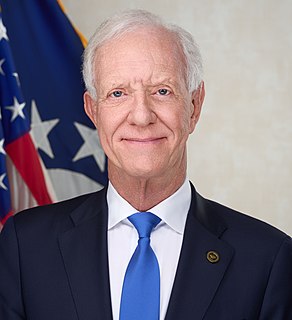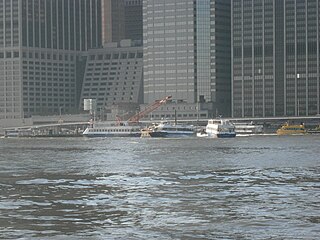
New York Harbor is at the mouth of the Hudson River where it empties into New York Bay near the East River tidal estuary, and then into the Atlantic Ocean on the east coast of the United States. It is one of the largest natural harbors in the world, and is frequently named the best natural harbor in the world. It is also known as Upper New York Bay, which is enclosed by the New York City boroughs of Manhattan, Brooklyn, and Staten Island and the Hudson County, New Jersey, municipalities of Jersey City and Bayonne. The name may also refer to the entirety of New York Bay including Lower New York Bay. Although the United States Board on Geographic Names does not use the term, New York Harbor has important historical, governmental, commercial, and ecological usages.

North River is an alternative name for the southernmost portion of the Hudson River in the vicinity of New York City and northeastern New Jersey in the United States. The entire watercourse was known as the North River by the Dutch in the early seventeenth century; the term fell out of general use for most of the river's 300+ mile course during the early 1900s. However the name remains in very limited use as an artifact among history-inclined local mariners and others and on some nautical charts and maps. The term is also used for infrastructure on and under the river, such as the North River piers, North River Tunnels, and the North River Wastewater Treatment Plant.

Air Florida Flight 90 was a scheduled U.S. domestic passenger flight operated by Air Florida from Washington National Airport to Fort Lauderdale–Hollywood International Airport, with an intermediate stopover at Tampa International Airport. On January 13, 1982, the Boeing 737-222 registered as N62AF crashed into the 14th Street Bridge over the Potomac River.

Hammocks Beach State Park is a North Carolina state park in Onslow County, North Carolina in the United States. Located near Swansboro, along the Southern Outer Banks, or Crystal Coast, the state park covers 1,611 acres (6.52 km2) and consists mainly of Bear Island. The park also owns three smaller islands, Dudley, Huggins and Jones, located in the nearby mouth of the White Oak River. After a recently completed deal, 319 acres (1.29 km2) acres on the mainland were added to the park.

NY Waterway is a private transportation company running ferry and bus service in the Port of New York and New Jersey and in the Hudson Valley. The company utilizes public-private partnership with agencies such as the Port Authority of New York and New Jersey, New Jersey Transit, New York City Department of Transportation, and Metropolitan Transportation Authority to provide service and maintain docking facilities.

The Port Authority of New York and New Jersey Police Department, or Port Authority Police Department (PAPD), is a law enforcement agency in New York and New Jersey, the duties of which are to protect and to enforce state and city laws at all the facilities, owned or operated by the Port Authority of New York and New Jersey (PANYNJ), the bi-state agency running airports, seaports, and many bridges and tunnels within the Port of New York and New Jersey. Additionally, the PAPD is responsible for other PANYNJ properties including three bus terminals, the World Trade Center in Lower Manhattan, and the PATH train system. The PAPD is the largest transit-related police force in the United States.

The Port of New York and New Jersey is the port district of the New York-Newark metropolitan area, encompassing the region within approximately a 25-mile (40 km) radius of the Statue of Liberty National Monument. It includes the system of navigable waterways in the New York–New Jersey Harbor Estuary, which runs along over 770 miles (1,240 km) of shoreline in the vicinity of New York City and northeastern New Jersey, as well as the region's airports and supporting rail and roadway distribution networks. Considered one of the largest natural harbors in the world, the port has become the second busiest port by tonnage in the United States as of 2019, and the busiest on the East Coast.

Hudson River Park is a waterside park on the North River that extends from 59th Street south to Battery Park in the New York City borough of Manhattan. The park, a component of the Manhattan Waterfront Greenway, stretches 4.5 miles (7.2 km) and comprises 550 acres (220 ha), making it the second-largest park in Manhattan after the 843-acre (341 ha) Central Park.

Weehawken Terminal was the waterfront intermodal terminal on the North River in Weehawken, New Jersey for the New York Central Railroad's West Shore Railroad division, whose route traveled along the west shore of the Hudson River. It opened in 1884 and closed in 1959. The complex contained five ferry slips, sixteen passenger train tracks, car float facilities, and extensive yards. The facility was also used by the New York, Ontario and Western Railway. The terminal was one of five passenger railroad terminals that lined the Hudson Waterfront during the 19th and 20th centuries; the others were located at Hoboken, Pavonia, Exchange Place and Communipaw, with Hoboken being the only one still in use.

The Haverstraw–Ossining Ferry is a passenger ferry which connects Haverstraw, New York with Ossining, New York over the Haverstraw Bay and Hudson River. The ferry operates during rush hours on weekdays only, primarily transporting commuters from the west side of the river to the Ossining Metro-North Railroad station on the east side, where they can transfer to Metro-North Railroad trains headed to Grand Central Terminal in New York City, or Croton-Harmon and Poughkeepsie, via its Hudson Line. Connections are also available at Ossining to the Bee-Line Bus System's 13 and 19 routes. The Ossining terminal is at a pier adjacent to the west side of the station, and the Haverstraw terminal is at a pier on the eastern end of Dr. Girling Drive.

On January 15, 2009, US Airways Flight 1549, an Airbus A320 on a flight from New York City's LaGuardia Airport to Charlotte, North Carolina, struck a flock of birds shortly after take-off, losing all engine power. Unable to reach any airport for an emergency landing due to their low altitude, pilots Chesley "Sully" Sullenberger and Jeffrey Skiles glided the plane to a ditching in the Hudson River off Midtown Manhattan. All 155 people on board were rescued by nearby boats, with only a few serious injuries.

Chesley Burnett "Sully" Sullenberger III is an American diplomat and retired airline pilot best known for his heroism as captain of US Airways Flight 1549 that he ditched in the Hudson River in 2009 after both engines were disabled by a bird strike. All 155 people aboard survived. He has served as the U.S. ambassador to the International Civil Aviation Organization (ICAO) since February 2022. Sullenberger became an outspoken advocate for aviation safety and has helped develop new protocols for airline safety. He served as the co-chairman, along with his co-pilot on Flight 1549, Jeffrey Skiles, of the Experimental Aircraft Association (EAA)'s Young Eagles youth introduction-to-aviation program from 2009 to 2013.

On August 8, 2009, at 11:53 a.m. (15:53 UTC), nine people died when a tour helicopter and a small private airplane collided over the Hudson River near Frank Sinatra Park in Hoboken, New Jersey. The aircraft were in an area known as the "Hudson River VFR Corridor", which extends from the surface of the river to altitudes of 800 to 1,500 feet at various locations along the Hudson River in the immediate area of New York City. Within this corridor, aircraft operate under visual flight rules (VFR), under which the responsibility to see and avoid other air traffic rests with the individual pilots rather than with the air traffic controller.

Pan Am Flight 526A, a Douglas DC-4, took off from San Juan-Isla Grande Airport, Puerto Rico, at 12:11 PM AST on April 11, 1952 on a flight to Idlewild International Airport, New York City with 64 passengers and five crew members on board. Due to inadequate maintenance, engine no. 3 failed after takeoff, followed shortly by engine no. 4. Nine minutes after takeoff, the aircraft ditched in rough seas 11.3 miles NW of San Juan Airport, broke apart and sank after three minutes. Panicking passengers refused to leave the sinking wreck. 52 passengers were killed, and 17 passengers and crew members were rescued by the USCG. After this accident it was recommended to implement pre-flight safety demonstrations for over-water flights.

Weehawken Port Imperial is an intermodal transit hub on the Weehawken, New Jersey, waterfront of the Hudson River across from Midtown Manhattan, served by New York Waterway ferries and buses, Hudson–Bergen Light Rail, and NJT buses. The district lies under and at the foot of Pershing Road, a thoroughfare which travels along the face of the Hudson Palisades, which rise to its west. The Hudson River Waterfront Walkway runs along the shoreline and is abutted by recently constructed residential neighborhoods, Lincoln Harbor to the south and Bulls Ferry to the north.
Water safety refers to the procedures, precautions and policies associated with safety in, on, and around bodies of water, where there is a risk of injury or drowning. It has applications in several occupations, sports and recreational activities.

Pier 11/Wall Street is a pier providing slips to ferries and excursion boats on the East River in the Port of New York and New Jersey. It is located east of South Street and FDR Drive just south of Wall Street in Lower Manhattan, New York City. The ferry terminal has five landings, each with two berths, and is used by four privately owned companies. Within walking distance, public transportation includes the New York City Subway's 1, N, R, and W trains at South Ferry – Whitehall Street and 2 and 3 trains at Wall Street; the M55, M15, M15 SBS, M20 New York City Bus routes, and the Staten Island Ferry at the Whitehall Terminal.

The Father Mychal Judge is a NY Waterway ferry named in honor of Mychal Judge, a New York City priest who was a victim of al Qaeda's attacks on September 11, 2001.

Governor Thomas H. Kean is a ferry operated by New York Waterways. On January 15, 2009, the ferry, under the command of Brittany Catanzaro, helped rescue the passengers of US Airways flight 1549, after the failure of both engines forced the aircraft to make an emergency landing on the Hudson River.

Brittany Catanzaro is an American sailor. She was the youngest individual appointed captain of a New York Waterways ferry, and the first woman appointed captain. Catanzaro captained the ferry Governor Thomas H. Kean, one of the vessels that responded to the emergency landing of US Airways Flight 1549, on the Hudson River. Catanzaro and her crew are credited with rescuing two dozen survivors.

















